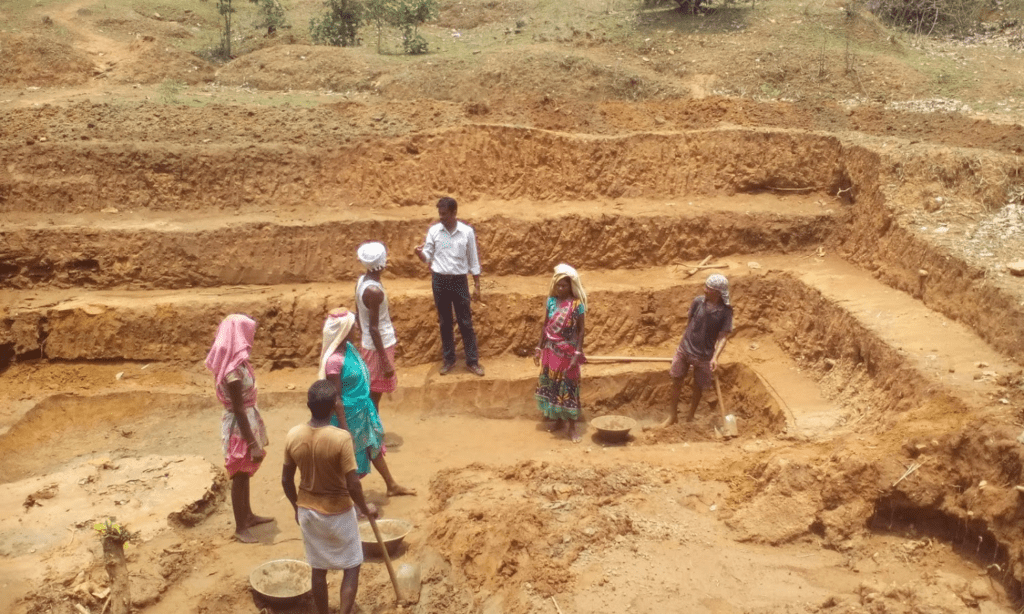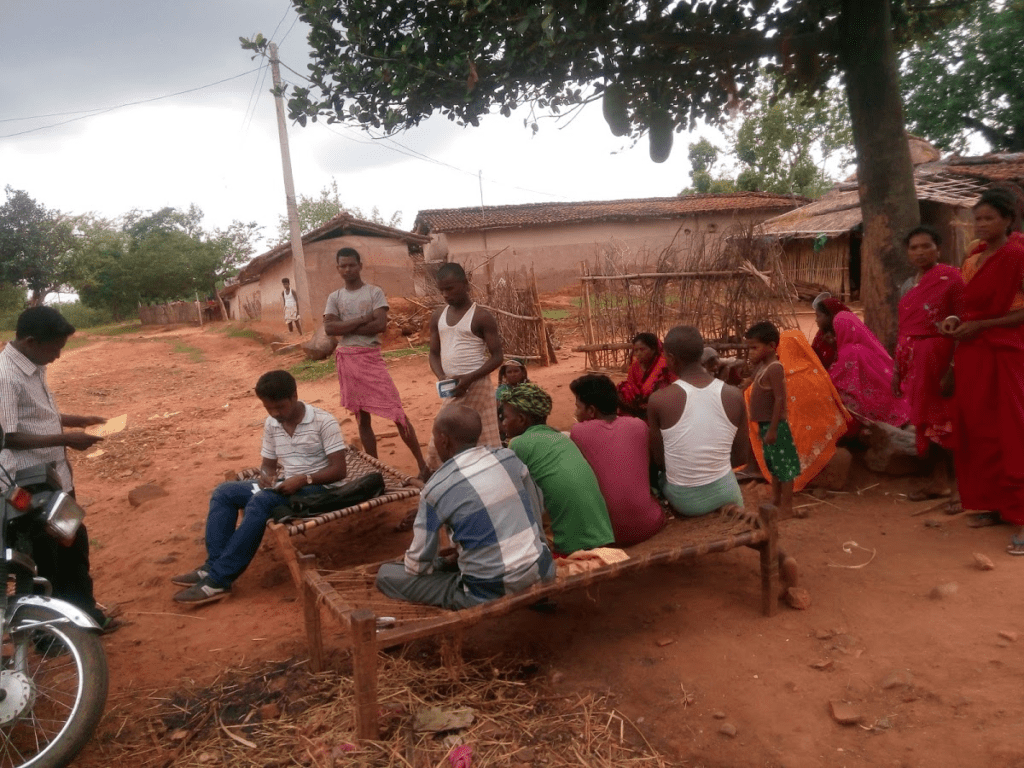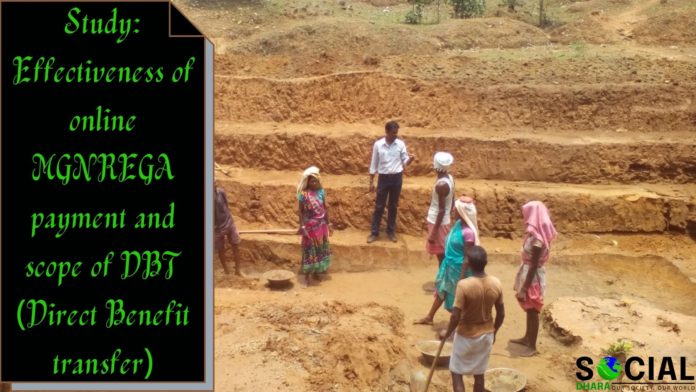Introduction:
National Rural Employment Guarantee Act 2005 (NREGA No 42, later renamed as the “Mahatma Gandhi National Rural Employment Guarantee Act”, MGNREGA), is Indian labor law and social security measure that aims to guarantee the ‘right to work’. It aims to enhance livelihood security in rural areas by providing at least 100 days of wage employment in a financial year to every household whose adult members volunteer to do unskilled manual work[1].

The MGNREGA was initiated with the objective of “enhancing livelihood security in rural areas by providing at least 100 days of guaranteed wage employment in a financial year, to every household whose adult members volunteer to do unskilled manual work”. Another aim of MGNREGA is to create durable assets (such as roads, canals, ponds, wells). Employment is to be provided within 5 km of an applicant’s residence, and minimum wages are to be paid. If work is not provided within 15 days of applying, applicants are entitled to an unemployment allowance. Thus, employment under MGNREGA is a legal entitlement. MGNREGA is to be implemented mainly by gram panchayats (GPs). The involvement of contractors is banned. Labor-intensive tasks like creating an infrastructure for water harvesting, drought relief, and flood control are preferred. Apart from providing economic security and creating rural assets, NREGA can help in protecting the environment, empowering rural women, reducing rural-urban migration, and fostering social equity, among others[2].
To streamline the fund flow mechanism and bring down delays in payment of wages, the Ministry of Rural Development has implemented National Electronic Fund Management System (NeFMS) in 24 States and 1 Union Territory. This process reduces the delay in allocation of funds for payment of wages to the States and removes parking of funds at various levels. As per NREGASoft, around 99% of the wages are being paid electronically (FY 2018-19 as of 24.07.2018) into the Bank/Post Office accounts of MGNREGA workers through the Electronic Fund Management System (eFMS). In FY 2013-14, only 37% of the wages were paid electronically.
The Ministry along with the States/UTs has been making concerted efforts for improving the timely payment of wages. States/ UTs have been advised to generate pay orders in time. This has resulted in considerable improvement in the status of the timely generation of pay orders and leading to improvement in the actual time taken to credit wages in the workers’ account. During the current Financial Year 2018-19 (as of 23.07.2018), 92% of pay orders have been generated within 15 days[3].
This document will provide an analysis of the insights of how effective is the online payment of MGNREGA. This will however let us know what are the in-depth challenges to the payment of DBT (direct bank transfer) to the beneficiaries of MGNREGA. The study is been carried out in the Hathras district of Uttar Pradesh.
Objective:
India is one of the most prominent examples of a developing economy that has a wide range of social protection programs but has always struggled with its implementation of ground. The Mahatma Gandhi National Rural Employment Guarantee Act (MGNREGA) is considered a key example of this social protection scheme which is developed by India. This scheme has proven to be the most widely implemented all over India and is working in most of the parts of India. Multiple studies are been carried out on this scheme and its implementation over its wage payment of DBT (direct bank transfer). The ways of payment and is it accessible to the rural parts of India are the biggest issues to these according to some reports. There are multiple reasons for the delay in the payments which we will be analyzing in this document. These will be the critical issues to the program and these issues will directly affect the beneficiaries of this scheme.
The main objective of the study:
- To study the functionality of MIS in MGNREGA’s work.
- Impact of DBT (Direct Benefit Transfer)
- Issues in Digital payments
- Another critical analysis that will be done is “Are MGNREGA beneficiaries “satisfied”?” with the process of online back transfer in their region.
Research Methodology:
Sampling:
This research was conducted in the Hathras district of Uttar Pradesh in the blocks Sikandrarao, Sasni, and Mursan. We have been able to conduct interviews in both qualitative as well as quantitative manner. Open-ended questions will be asked in a structured interview. A simple random sampling method will be used for the selection of the wage-seekers and respondents. The exhaustive research will be carried out to gain an insight into the impacts on the marginalized workers and MGNREGA.
Assessment tools:
Two categories of respondents were identified as key participants in the research namely the migrant workers (both male and female) and the administrative experts from the MGNREGA, Rural Development Department, Government of Uttar Pradesh. Assessment tools include:
- Research Questionnaire
- Individual Interview
- For each assessment tool, a set of both open and closed-ended questions were identified to get the maximum responses.
Data Collection:
Data collection will be done in written format and it will be monitored by the researchers themselves daily during the research period. Each data set/questionnaire will be thoroughly scrutinized for errors while entering the responses. On proper validation of filled questionnaires, the data were entered into Microsoft Excel daily.
Secondary data is necessary to gain the statistical insights of the data which is provided by the government officials. The MGNREGA data will be gathered from the block office and panchayat office, respectively.
Ethical considerations:
It was very important to maintain the privacy of the respondents during the research. At the time of data collection, the verbal administration of informed consent will be undertaken. For FGD, the participants were not very comfortable signing the sheet hence verbal consent will be taken to conduct the discussion. The consent was enclosed with the following points:
- Introduction of researcher/interviewer/facilitator and information about the organization
- Brief information on the assessment
- Assurance of confidentiality (FGD)
- Empower respondents to draw back their participation at any point of focus group discussion
Limitations:
Since this research was conducted in the time of Covid 19, the researcher was unable to conduct the full-fledge FGD with both the women as well as men participants. The gram panchayat didn’t allow the participation of the community but the researcher still managed to conduct the FGD with the community somehow. Due to the limitation of the present Covid 19 time, we have reduced our sample size from 25 to 13 participants, out of which 12 were the MGNREGA beneficiary and one with the MIS District officer.
Findings:
Following were the key finding of the research work carried out for learning purposes.

- There were 12 respondents in the interview. All respondents replied that other family members were also engaged in MGNREGA work. All family carried ‘active’ job cards.
- The average family size of respondents was 7. 3 people/family were reported to work under MGNREGA.
- Avg working days for the interviewed household was 122.
- Payment releases generally 25 days on average after the generation of muster roll.
- Four households said no issue with the payment system
- All 12 respondents replied about receiving DBT payment from MGNREGA.
- Most of them were used to with the online platform of the payment system. They receive money from the Gas subsidy, PM Kisan Samman Nidhi, SHG fund, pension, KCC, single child scholarship, and so on. Less than 25% of people were not comfortable with an online payment system. They have fear of fraud.
- Most of the people agreed on getting online payment time. This digital payment has increased its lifestyle. Very few were not agreed with the online payment system fearing being cheated.
- Half of the respondents were satisfied with the digital payment process and half of them were still looking for better services through the online platform.
- The MGNREGA officer replied that there is constant improvement in MIS and digital payment for transparency and timely payment.
- For any changes in the payment system, concerned personnel from the district office get training followed by a block, panchayat, and village team. Apart from that, they also get capacity-building training at least once a year along with giving/takes suggestions for payment issues.
- The current process of payment was is made online. The process is initiated with the generation of an e-muster roll, then FTO generation, and finally money transfer to a concerned bank account.
- The current tracking system was made through field staff with physical verification only.
- The online payment system was said very well and time-saving for staff. It also gives transparency and can create records anytime.
- Impact on livelihood among workers – according to respondent’s observation the workers do not need to visit far away for getting their wages, this also reduces their extra cost and time saving too. This time could be used for another money-earning activity.
- The district has a digital payment process and they follow it strictly.
- The digital payment process is very useful for both side workers and administration in terms of transparency. However, there could be a usual delay in payment that is because of payment approval from concerned officials.
- The district administration promotes the digital payment process extensively through IEC activities, mobilizing of wage seekers, SHG groups. This includes the benefits of digital payment, transparency, and fast process.

Discussion:
- The first one was to safety issue which needs to be resolved.
- People need some awareness of the benefit of using digital payment
- Concerned stakeholders need to be trained to smoothly use the online platform.
- Apart from a user, the service provider needs to accept the digital payment system on large scale for converting the village into a digital or smart village.
- A tracking system is still physical, not much advanced and there is a requirement for an advanced digital system.
- In the question of making any mistake while online payment, the respondent did not respond to the question of how they correct the mistake.
Conclusion:
Overall, it was concluded from the research work that MGNREGA creates a good impact on people’s livelihood. However, they faced many challenges due to the absence of digital payment entirely. The government of Uttar Pradesh has emphasized DBT (Direct Benefit Transfer). The process is no doubt time taking. digitalization can be successfully done once the service provider and receiver accept it completely. This research work allowed a student to understand the topic and issue in digital payment on the ground.
References:
- nrega.nic.in/netnrega/home.aspx
- rural.nic.in/press-release/direct-benefit-transfer-under-mgnregs
- pfms.nic.in/NewDefaultHome.aspx
- rural.nic.in/press-release/direct-benefit-transfer-under-mgnregs
[1] simdega.nic.in/en/scheme/mahatma-gandhi-national-rural-employment-guarantee-act-mgnrega/#:~:text=National%20Rural%20Employment%20Guarantee%20Act%202005%20(or%2C%20NREGA%20No%2042,the%20’right%20to%20work‘.
[2] simdega.nic.in/en/scheme/mahatma-gandhi-national-rural-employment-guarantee-act-mgnrega/#:~:text=National%20Rural%20Employment%20Guarantee%20Act%202005%20(or%2C%20NREGA%20No%2042,the%20’right%20to%20work’.
[3] rural.nic.in/press-release/direct-benefit-transfer-under-mgnregs



[…] Also Read Study: Effectiveness of online MGNREGA payment and scope of DBT (Direct Benefit transfer) […]